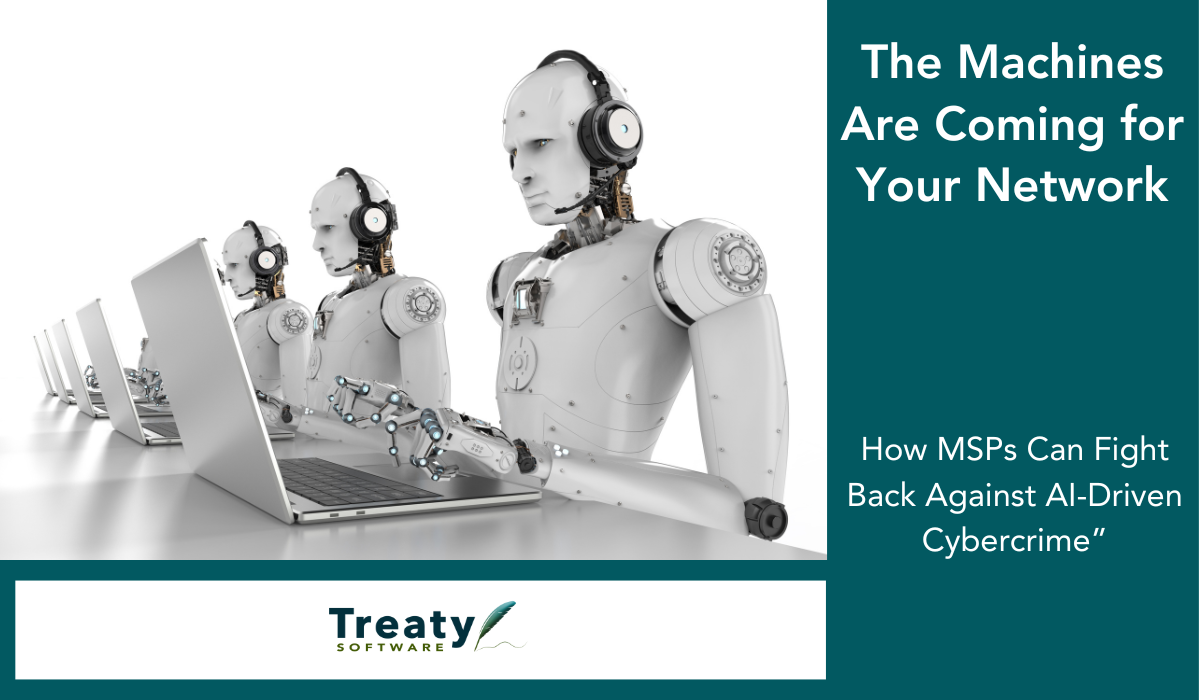In today’s cyber-threat landscape, adversaries are using artificial intelligence (AI) not just defensively, but aggressively. Attackers aren’t guessing — they’re automating. They can write convincing phishing emails, mimic real voices, and spot vulnerabilities instantly. It’s efficient, relentless, and evolving fast.
That evolution has serious implications for managed service providers (MSPs) and their clients. MSPs must defend against AI-enabled attacks while also adapting their contracts, liability models, and service delivery to survive in this new era.
Specific Threat Examples
Cybercriminals no longer rely on human-crafted phishing templates or manual threat hunts. They’re using AI to amplify and automate their operations. For example:
- Generative-AI models are crafting extremely convincing spear-phishing and deep-fake social engineering campaigns — exploiting voice, image, and text mimicry to deceive users. A recent report found that 63% of 3,000 IT and cybersecurity professionals identified AI-driven social engineering as a major challenge for 2026.¹
- Autonomous reconnaissance and kill-chain prediction tools are being developed to identify potential victim systems in real time, map attack paths, and execute lateral moves with minimal human oversight.²
- Surveys show that 63% of C-suite executives believe AI-enhanced threats could render existing defences obsolete every few months — more than double the previous year.³
For MSPs, this means the attack surface is transforming — it’s faster, smarter, more scalable, and increasingly automated. Traditional perimeter-based defences or static, signature-driven tools are no longer enough.
Practical Strategies for MSPs
To stay ahead, MSPs must move from purely reactive models to proactive, adaptive ones:
- Integrate AI-capable defensive tools (for example, anomaly detection or behavioural modelling) while maintaining human expert oversight. AI isn’t a substitute for experience — it’s a force multiplier.
- Adopt layered, adaptive controls: Zero-Trust architectures, multi-factor authentication (MFA) for all clients, and continuous monitoring for anomalies, especially around privileged accounts and API usage.
- Include AI-readiness consulting in service offerings: Many clients will deploy generative-AI or large-language models (LLMs) without sufficient security maturity. MSPs can position themselves as trusted advisors to bridge that gap.
- Develop incident-response playbooks designed for AI-enabled threats — with faster detection, automated triage, and clear escalation paths when AI triggers require human review.
Contracting, Liability & Insurance Implications
As threats evolve, MSPs must revisit how they contract with clients and manage risk:
- Service Level Agreements (SLAs) and Master Services Agreements (MSAs) should explicitly cover scenarios involving AI-based threats. Who is liable if an attack is triggered by AI-generated content (for example, a deep-fake impersonation)? How are response responsibilities shared?
- Cyber-liability insurance will need updating. Insurers increasingly expect proof of AI-capable defences, regular red-teaming against AI attack vectors, and documented oversight of AI workflows.
- Contracts should include: audit rights, AI tool maintenance responsibilities, staff training requirements (both for client and MSP teams), and clear indemnity language covering the “known unknowns” of AI exploitation.
- From an advisory perspective, MSPs should ensure clients embedding AI in their own systems follow security-by-design principles — including robust data governance, model validation, and human-in-the-loop controls.
Case Study / Vendor Move
A recent example: Kaseya’s acquisition of INKY (announced 7 October 2025) highlights how MSP-focused vendors are embedding AI into their platforms. INKY adds generative-AI-powered email security, helping MSPs defend against highly sophisticated phishing and impersonation campaigns.⁴
This move underscores both the demand for AI-driven security within the MSP ecosystem and how vendors are adapting. For MSPs, that means:
- Expect consolidation and deeper tool integration: unified dashboards combining email, identity, endpoint, backup, and AI analytics.
- Evaluate vendor AI claims carefully — demand transparency about training data, false-positive rates, and human oversight.
- Seize the opportunity to differentiate by offering “AI-enhanced defence” as a premium service tier. Many clients will pay more for higher confidence against AI-enabled threats.
Final Thoughts
So, where does this leave MSPs? In short, right in the middle of a massive shift — and an even bigger opportunity.
The same AI that fuels cybercrime can also become your most powerful defensive ally.
But success requires more than just new tools; it demands smarter contracts, sharper oversight, and steady human judgement. By embracing this shift proactively, MSPs can position themselves as strategic — not just operational — partners to their clients.
Those who lean into AI — thoughtfully, transparently, and strategically — will set the new standard for cybersecurity in 2026 and beyond.
Footnotes
- “AI-Driven Social Engineering Top Cyber Threat for 2026, ISACA Survey Reveals”, Infosecurity Magazine. (infosecurity-magazine.com)
- “Cyber Threat Intelligence: AI-Driven Kill Chain Prediction”, Cloud Security Alliance. (cloudsecurityalliance.org)
- “Will AI Cyber Threats Outpace AI Defenses?”, Forbes. (forbes.com)
- “Kaseya expands backup portfolio, acquires email security specialist INKY”, IT Pro. (itpro.com)

